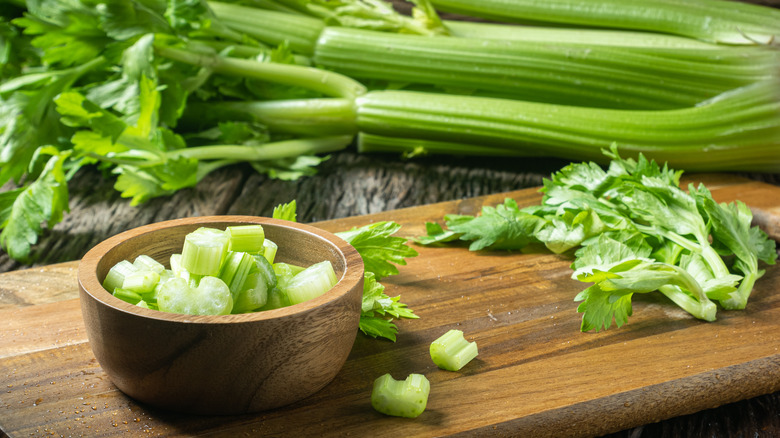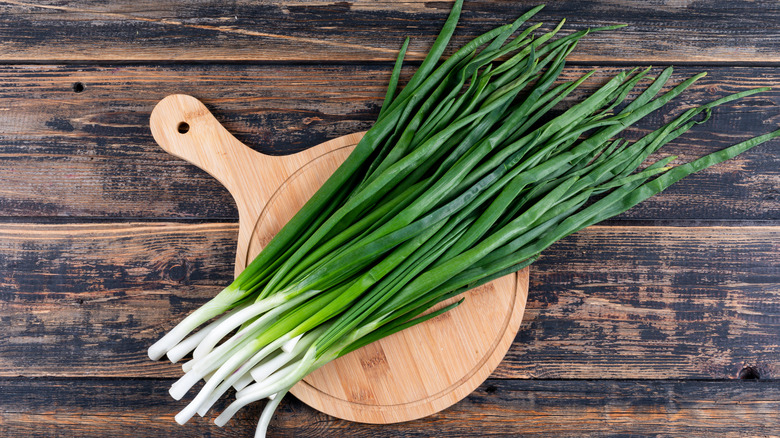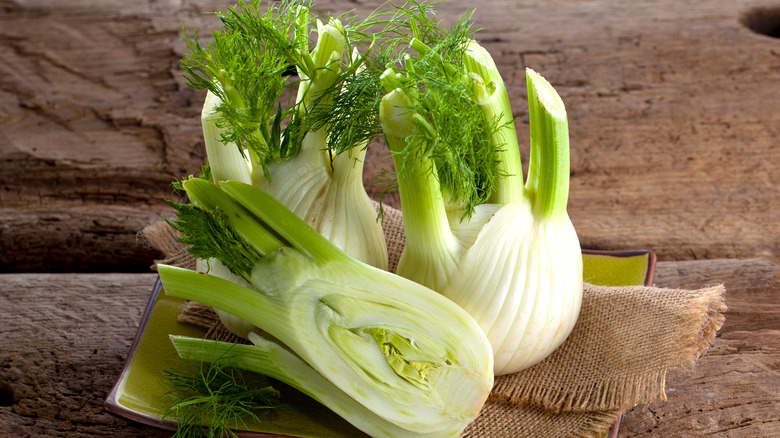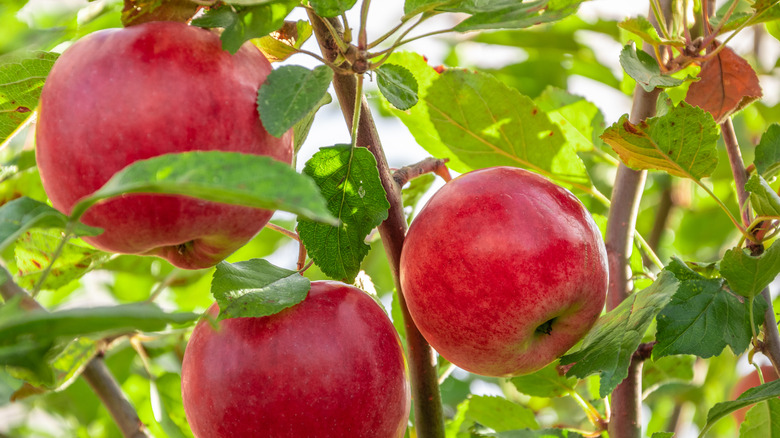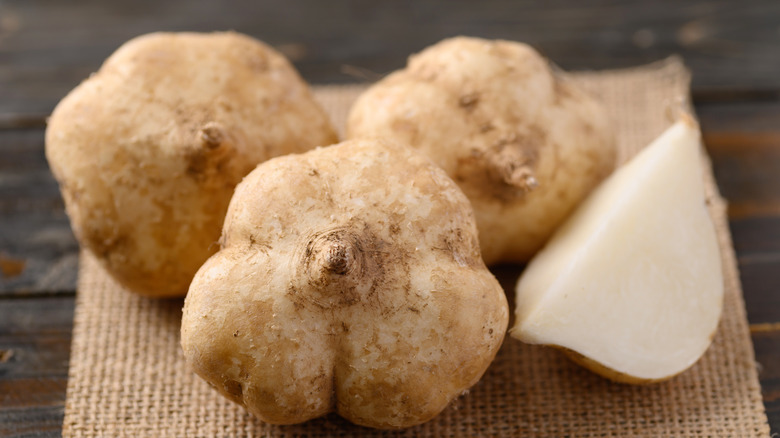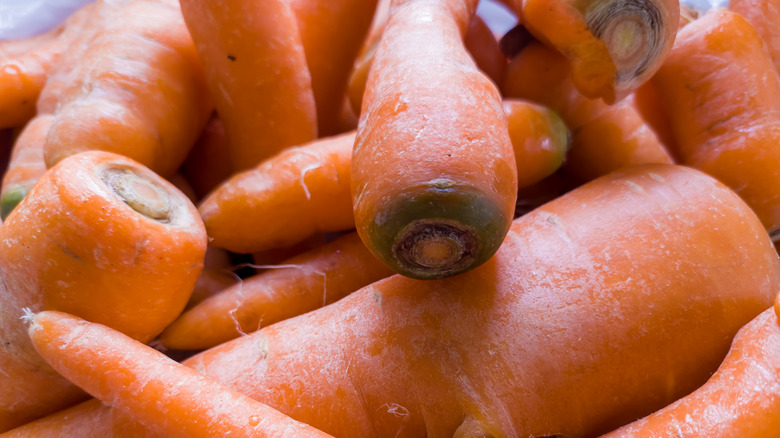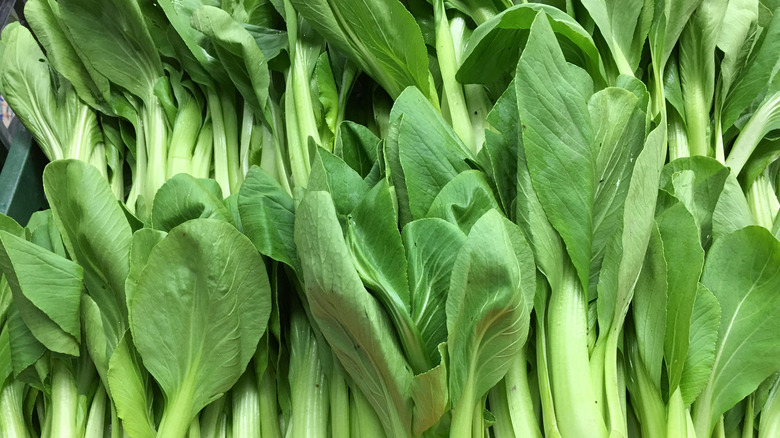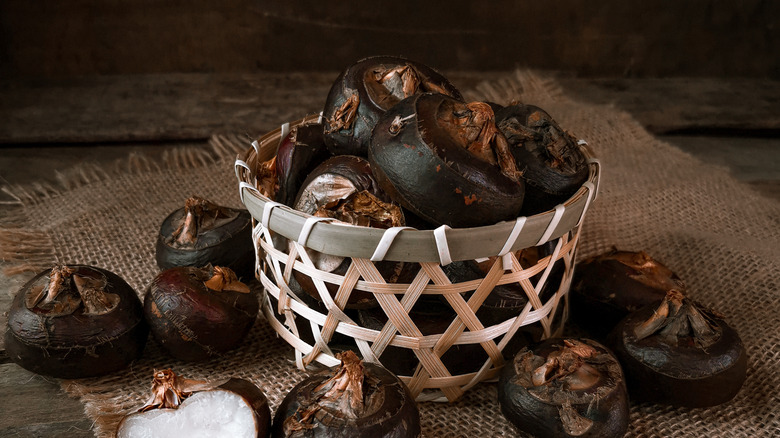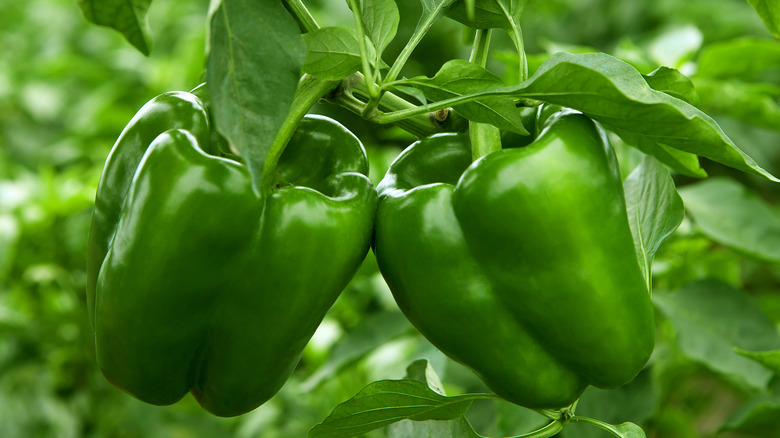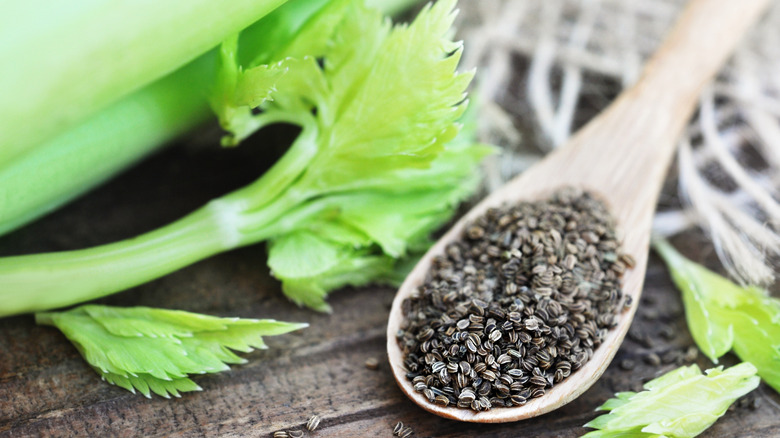9 Best Substitutes For Celery
From ancient Egyptians using celery seeds and leaves as herbal medicine to cooks across America covering the vegetable with peanut butter and raisins, this crucial food has always played an important role in cultures across history (via American Botanical Council). The uses for this tall, slender, crisp green stalk with fluffy, rugged leaves are plentiful. Almost any basic chicken soup stock has a few stalks of long green celery floating around in there somewhere and no Thanksgiving stuffing comes complete without some bits of celery mixed in.
While so many recipes call for this versatile ingredient, sometimes it can be hard to procure a stalk or three. Whether the celery at your local grocery store looks a bit brown, prices have jumped, or you flat out just don't like the vegetable, sometimes you need a backup plan. Fortunately, there are plenty of substitutes for the tall, slender stalk that will satisfy the requirements for any celery-based recipe. According to A Couple Cooks, a medium celery stalk equates to ½ cup of chopped celery, letting you adjust your recipes as needed.
1. Green onions
You can usually find these little green guys atop a loaded baked potato. Green onions have a very mild flavor — the bottom white section has a sweet, onion-like flavor, while the greener part of the vegetable has a fresh and earthy flavor. They can provide that signature crunch you would look for in salads or as a topping to a variety of meals. If you want to cook your ingredients instead of simply tossing them all together, you may find that green onions provide a slightly more distinct taste to your dish instead of the usual celery. It's recommended to substitute green onions for celery in uncooked dishes to help preserve the distinct texture green onions provide.
A Couple Cooks offers a simple ratio when you need to substitute celery for green onions — replace ½ cup of cut celery with a ¼ cup of chopped green onions. For example, if you're preparing an egg salad that requires ¼ cup of chopped celery, it's best to use ⅛ cup of green onions, as the flavor profile of the green onions may overpower the salad if overused.
2. Fennel
This bulbous-looking little guy with its stalks and stringy green leaves may not look like the most appealing to use for celery, but don't doubt for a second that fennel isn't a quality substitute. Fennel has been described as having a peculiarly sweet flavor, tasting like subtler anise or even licorice. Don't worry — the sweetness of fennel can't overpower any dish and even mellows out a bit when you cook the ingredient. The bulb, seeds, and stalk of the fennel can all be prepared and eaten however you please. In fact, one could use the crisp stalks of the fennel as a replacement for chopped celery in salads, while the bulb has a very soft, silky texture similar to celery when cooked.
If you're preparing a soup or a stew that requires you to add celery, you can simply add a bit of chopped fennel stalk to add to a base instead. This substitution alters the flavor a bit, but the subtle sweetness of the cooked fennel easily matches the subtle bitterness of the celery just as well. If you save the fennel fronds, you could also use them to prepare a wide variety of dishes, such as pestos, curries, garnishing stir-fries, or even fennel oil (via Bon Appétit). For an estimate on how much fennel one should use, one fennel bulb equates to 2 or 3 medium celery stalks (via A Couple Cooks).
3. Apples
You would probably expect celery substitutes to fall more in the vegetable department, but apples can help scratch that itch when you need a quick stand-in. While apples aren't the best replacement for celery in a braising stock for beef or the base for chicken soup due to their different flavor profiles, apples and celery both share a textural factor in common — the crunch.
When one mixes celery into a fresh summer salad and takes a bite, you really don't notice any overpowering flavor and only pay attention to an ice-cold and crunchy texture. Apples provide a rich, distinct, tart flavor to your salad, as compared to the cool crunch that celery usually provides. This fruit also comes in a variety of flavors, from the juicy and pear-tasting Ambrosia Apples to the tart green crispness of the Granny Smith, allowing you to have a bit more flavor options when substituting celery (via Stemilt).
According to What's Cooking America, grating a small apple will give you ½ cup of fruit, the same as a medium celery stalk. If a recipe called for 2 cups of celery in a salad, you simply need 2 cups of grated apples.
4. Jicama
Described as a globe-like vegetable with papery brown skin and a white interior, jicama originated in Mexico and spread across Asia (via Healthline). Some describe its flesh as juicy and crunchy, with a sweet and nutty flavor to it. Others have even picked up notes of potato, pear, and even water chestnut. Jicama may help promote healthy digestion and prevention of cardiovascular diseases, although the beans of the Jicama root contain a poison (via LiveStrong).
Jicama is perfect for celery substitutions in salads thanks to its crunchy texture and mild flavors, but also has the power to replace cooked celery. All one simply needs to do is ensure that the jicama is not overcooked, in order to prevent it from losing its crunch and becoming too mushy. While you may think this may be hard to find, it's actually available at your local Walmart or Amazon, so feel free to check when they have this vegetable in stock. You can replace ½ a cup of chopped celery with ½ a cup of grated jicama. A pound of jicama shreds down to 4 cups, meaning you can replace up 8 medium stalks of celery with just a bit of this fantastic substitution (via Gourmet Sleuth).
5. Carrots
Long, orange, crisp, and reminiscent of a cartoon rabbit with a Flatbush accent, the ever-common carrot is a fine backup when you need to replace some celery in a dish. When raw, it has a light crunch and a somewhat earthy taste, and when cooked, it is much softer and has a light sweetness (via Harvest to Table). Its texture and flavors make it a great choice to use when making soups alongside celery.
In fact, carrots can be used without celery when making a hearty broth, as even without celery, you'll still have the usual deep flavors of what you would expect of a soup broth. If you're looking to make your soups or sauces just a tad sweeter, feel free to add a bit more carrots than celery, and season how you feel like it to achieve the balance of sweet and savory. Carrots also contain a wide assortment of vitamins and minerals, though the myth of turning your skin orange still is up for debate, according to the Cleveland Clinic.
For substitutions, you will need 1.5 carrots to get ½ cup of shredded carrots. Each ½ cup of shredded carrots can replace ½ cup of chopped celery in many recipes, per Produce Converter.
6. Bok choy
Bok choy is a vegetable that shares celery's green leaves and white bulbs. According to Thrive Cuisine, the dark green leaves are very soft, and the stalks provide the familiar crunch that you would expect from celery. It has a crisp spinach-like taste with subtle peppery undertones. In fact, most of this vegetable is roughly 95% water, so don't worry about it being too filling or upsetting the calorie levels of whatever you trying to make.
Its crunchy texture and flavor profile make it perfect for use in soups or stir fries, as well as providing a bit of familiarity with its celery-like stalks. If you're trying to substitute bok choy in a salad or soup, it's comforting to know that with these stalks in the mix, no one will be able to tell the difference. If you're looking for a sweeter taste, it is recommended you try baby bok choy first, as the leaves of this plant taste less bitter than their mature counterpart (via Gardening Know How). When substituting for celery, it is best to use ½ cup of bok choy for every ½ cup of chopped celery.
7. Water chestnuts
Water chestnuts may look like your average chestnut from afar, but these aquatic little guys are just as useful and versatile in giving your celery-centric dishes a bit of an extra kick of flavor. According to Serious Eats, water chestnuts boast a crisp white flesh that could remind you of the stalks of celery, while they have a texture similar to pears. Their flavor profile combines a sweet, fruity taste and a nutty, tart taste together. Some have even described this flavor as a cross between an apple, pear, and coconut. When combined into a dish, their crispy texture helps provide the usual textures one expects when adding celery to a dish.
If you are using water chestnuts as a substitute for celery, make sure to pick up fresh water chestnuts, as canned ones can't replace celery. For substitution purposes, use ½ cup of water chestnuts for every ½ cup of celery needed.
8. Bell peppers
The choice is yours when it comes to selecting green, red, or yellow bell peppers in lieu of celery (via Nature Fresh). While this variety of pepper has a sweeter taste than their spicier counterparts, it's important to note not all bell peppers taste the same. Green peppers are said to have a more earthy taste that is closer to celery than red or yellow peppers, but it's up to you how you would want to use them in your dish. If you want a sweeter kick, opt for red and yellow peppers in your dish instead.
You can substitute a diced green bell pepper for celery in meat dishes, while slices of the pepper work better in Thanksgiving stuffing. Bell peppers also provide a nice dash of color to any dish and thanks to their sweet and earthy flavors, this vegetable provides the perfect stand-in when you need a celery substitution. You can replace 1 cup of chopped celery with 1 cup of chopped bell pepper in any recipe (via Michigan State University).
9. Celery seed
If you've tried all these suggestions and just miss the taste of celery, you still have one more substitution at your disposal. Celery seeds are harvested from wild celery. Wild celery has a more robust flavor and its seeds have a slightly bitter and earthy taste. Celery seeds avoid the common problems of celery stalks, such as stringy textures and the occasional chunk that ends up feeling too mushy. These seeds can't solve every problem, but in a pinch, they provide the no-nonsense, no-problem solution you're looking for in soups, meats, pickles, and even Bloody Marys (via The Epicentre).
An exact ratio for this type of seasoning doesn't exist, so it mostly depends on one's personal tastes. Feel free to experiment with different amounts of celery seed to find the amount that suits you best.
